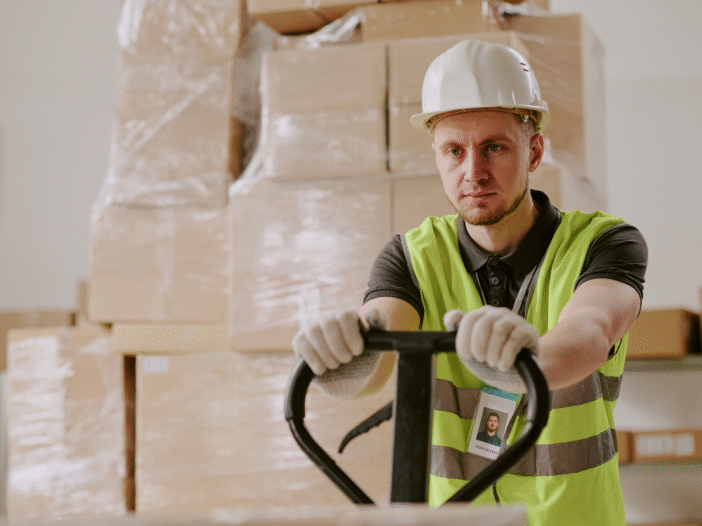
Running a small business means juggling sales, cashflow, HR, tax and delivery. Consequently, health and safety can slip down the list until a tender lands or, worse, an incident occurs.
This guide sets out a practical, proportionate approach to health and safety for small business that’s quick to set up and easy to maintain, helping you evidence compliance, prevent incidents and stay focused on growth.
Health and safety for small business – why it matters
These are the reasons why health and safety is essential for small businesses:
Legal compliance
Health and safety sits on the same legal footing as tax and employment obligations.
Under the Health and Safety at Work etc. Act 1974 (HSWA) you must, so far as is reasonably practicable, protect employees and anyone affected by your work (visitors, contractors, clients and the public).
In practice, compliance means having access to a competent person, keeping a written policy if you have five or more employees, and carrying out suitable and sufficient risk assessments (Management of Health and Safety at Work Regulations 1999 (MHSWR) reg.3).
The MHSWR 1999 also require you to:
- Plan, organise, control, monitor and review your health and safety arrangements. Keep a simple system, check it regularly, and update it when things change.
- Provide information, instruction and training. Give people the health and safety training they need for their role at induction, when work or equipment changes, and through periodic refreshers, and keep a basic record of completion.
- Appoint competent health and safety support. Make sure you have someone with the right skills, knowledge, experience and training to advise you—this can be in-house or external. Provide them with a clear remit, enough time and the authority to be effective.
Under the Safety Representatives and Safety Committees Regulations 1977 and the Health and Safety (Consultation with Employees) Regulations 1996 you are also required to consult with employees about health and safety arrangements that affect them.
The Regulatory Reform (Fire Safety) Order 2005 requires the “responsible person” to carry out and keep up to date a suitable fire risk assessment, maintain appropriate fire precautions, and provide relevant fire safety information, instruction and training. The responsible person is whoever has control over the property, such as the employer or landlord.
You must also make adequate and appropriate first-aid provision under the Health and Safety (First-Aid) Regulations 1981 and, unless exempt, hold at least £5 million employers’ liability insurance with an authorised insurer under the Employers’ Liability (Compulsory Insurance) Act 1969, with the certificate available to staff.
For a comprehensive list of the main health and safety regulations your business may need to comply with, please read the TUC’s guide, What are the main health and safety regulations?
Accident prevention
Most SMEs operate in ‘low risk’ office settings, but the risks with real impact are familiar and mostly preventable. These are some examples of common risks for small businesses and how to manage them:
- Display screen equipment (DSE): Risks can be reduced through ergonomic assessments, taking regular breaks, and ensuring workstations are set up correctly.
- Driving for work: Safety is supported by vehicle checks, careful journey planning, and clear rules on rest periods and mobile phone use.
- Manual handling and slips, trips and falls: Incidents can be prevented through training, maintaining safe working environments, and following good housekeeping practices.
- Stress and fatigue: These risks can be managed by setting realistic workloads, encouraging open communication, and providing wellbeing support.
Sensible, proportionate controls, including health and safety training on specific risk areas like Slips, Trips and Falls, reduce incidents and the long-term conditions that quietly erode wellbeing and productivity.
Business protection
Getting health and safety for small business right pays for itself. Robust yet concise documentation and evidence of training help you pass supplier questionnaires and pre-qualification checks, opening doors to new contracts.
Clear risk control reduces incidents, civil claims and downtime, and helps keep insurance premiums in check. If a regulator does visit, having your policy, risk assessments, maintenance checks and training records to hand minimises disruption and the likelihood of enforcement action or fees for intervention (see ‘Consequences of inaction’ below).
Just as importantly, visible care for people strengthens culture and retention. Employees stay longer, perform better and become advocates for your brand.
Consequences of inaction
Regulators (HSE, local authority or Fire & Rescue) can visit to assess how you manage risk, often without prior notice. If they find gaps, consequences range from written advice and improvement notices to fines, prosecutions, or even enforcement action that disrupts operations.
Enforcement notices and costs
If material breaches are found, inspectors can issue Improvement or Prohibition Notices, requiring you to fix issues by a deadline or stop dangerous activities immediately.
Where the HSE identifies a material breach a Fee for Intervention (FFI) may apply, charging you for the time spent investigating and following up.
Civil claims and insurance implications
Employees who suffer work-related injury or illness can bring civil claims. UK employers must hold employers’ liability insurance (usually at least £5 million) to cover compensation. Insurers commonly ask for evidence of your risk controls and training, and weak evidence can affect premiums and renewals.
Public visibility and reputation
The HSE publish enforcement outcomes, notices and convictions, on a public Register of Convictions and Notices.
Clients, prospects and the media can (and do) view these records, so poor control can quickly become a reputational as well as operational risk.
Cost-effective health and safety for small business
Most SMEs cannot justify the expensive of a full-time health and safety role. What works is a lean operating model: invest a little up front to build the system, then keep it alive with light-touch reviews and on-call expertise.
Health and safety for small businesses: top tips
Get the basics in place
Start with two core foundations:
Create a tailored health and safety policy
Keep your health and safety policy short, specific, and true to how you work. It should cover your intent (signed by the managing director), who does what, and how you manage key risks. Update it whenever changes occur (and at least annually).
If your policy says ladders are inspected monthly, make sure records exist or set a realistic frequency. See our article, Workplace health and safety policy sample, for guidance.
Complete proportionate risk assessments
Ensure risk assessments are proportionate and relevant to your work. For most small businesses the following risk assessments will be necessary:
- Display screen equipment (DSE)
- Fire safety
- Driving for work (including grey fleet)
- Manual handling
- Slips, trips and falls
- Lone working
- Contractors/visitors
Turn assessment findings into daily practice through clear instructions, briefings, toolbox talks, or health and safety eLearning. Build them into inductions, refreshers, and place prompts where work happens. Keep a register with review dates to ensure they remain current.
Assign responsibilities and involve the right people
The employer or managing director is ultimately accountable for health and safety but may appoint a co-ordinator (e.g. office manager). That person must have access to a competent person—either trained in-house or external.
Use a simple RACI (Responsible, Accountable, Consulted, Informed) table to clarify who approves the policy, updates action logs, reports incidents (including to RIDDOR), completes DSE and fire checks, and who your first aiders and fire wardens are. Delegating with visibility ensures ownership is clear.
Training and competence
Provide employees with:
- Health and safety induction training.
- Role-specific training. At Praxis42 we can adapt health and safety training to your roles and processes.
- Training when processes, equipment or staff change.
- Periodic refresher training.
Maintain a training matrix with completion and renewal dates to track progress.
Review little and often
Set straightforward review routines with clear timings, such as:
- Weekly or monthly fire alarm tests
- Annual display screen equipment (DSE) reviews
- First aid kit and fire extinguisher checks.
Hold brief quarterly management reviews to track actions, incidents/near misses, and upcoming changes. Use these to confirm responsibilities are being met, actions are closed on time, and controls are happening in practice.
Stay proactive
Run a quick baseline check of your health and safety arrangements:
- Ensure your health and safety policy is up to date.
- Confirm that all key risk assessments have been completed.
- Check that actions are clearly owned and assigned.
- Verify that training records are current.
Proportionate, preventative controls are more cost-effective than reactive fixes and put you in a strong position for audits, bids and renewals.
Ask for help when you need it
When time is tight or specialist input is required, bring in external support for:
- Fire risk assessments
- Incident investigations
- Insurer risk-improvement actions
- Contractor management
- Independent reviews of policies, risk assessments and training records.
Our retainer Helpdesk service provides small businesses with templates, a virtual gap audit, and rapid access to competent advice, which is an extremely cost-effective way to stay compliant without adding headcount.
Practical first steps (a 30–60-day plan)
Getting started with health and safety management is easier if you break it into clear phases. This 30–60-day plan sets out practical actions to establish your basics, identify key risks, and put the right controls and records in place.
- Week 1–2: Foundations – appoint your competent person, refresh your health and safety policy, and set up a central folder for policy, risk assessments, action log, training records and inspections.
- Week 3–4: Understand your risks – complete core risk assessments and create an action log with owners and due dates.
- Week 5–6: Put controls in place – deliver role-specific briefings, record completions, and introduce simple checks (e.g. fire alarm test log, first aid kit checks). Document emergency arrangements and prepare a one-page client pack with essentials.
- Ongoing – review whenever there are changes to processes, equipment or staff, and annually, log incidents/near misses, and keep evidence tidy so you can show compliance quickly.
The mindset that works
- Proportionate: Do what’s sensible for your risks—no more, no less. Match time, budget and controls to the likelihood and potential harm, and avoid gold-plating low-risk tasks.
- Practical: Keep documents short, set clear actions, and keep evidence tidy. Use plain English and a single shared folder so anyone can find the current policy, assessments and records in seconds.
- Progressive: Build firm foundations, then improve over time. Set small quarterly priorities and track a few measures (for instance, overdue actions, training completion and incidents) to keep momentum.
- People-first: Caring for employees is smart business, and the foundation of a positive culture. Involve employees in decisions, act on feedback, and you will see improved engagement, fewer absences and stronger retention.
Affordable health and safety consultants for small businesses
At Praxis42 we make health and safety for small business affordable and accessible, with on-demand consultancy support and flexible eLearning.
Our Helpdesk service gives you direct access to qualified consultants for advice when you need it, while our eLearning courses provide flexible, cost-effective training for your team.
Protect your people, stay compliant, and keep health and safety manageable, without stretching your budget.
Contact our friendly team today on 0203 011 4242/info@praxis42.com

Adam Clarke
Managing Director (Consulting)
